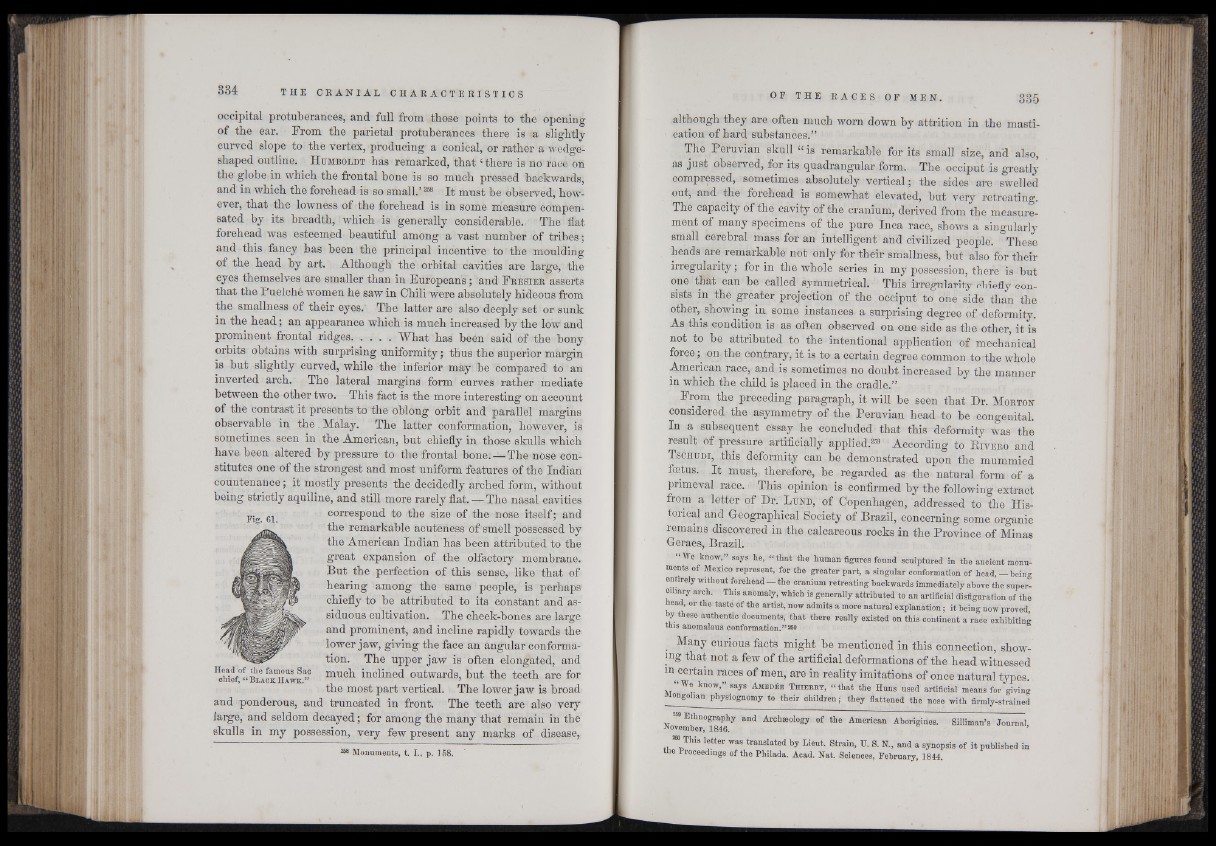
occipital protuberances, and full from those points to the opening
of the ear. From the parietal protuberances there is «a slightly-
curved slope to the vertex, producing a conical, or rather a wedge-
shaped outline. H umboldt has remarked, that ‘there is no race on
the globe in-which the frontal bone is so much pressed backwards,
and in which the forehead is so small.’258 It must be observed, however,
that the lowness of the forehead is in some measure compensated
by its breadth, which is generally considerable. The flat
forehead was esteemed beautiful among a vast-number of tribes ;
and this fancy has been the principal incentive to the moulding
of the head by art. Although the orbital cavities are large, the
eyes themselves are smaller than in Europeans ; and F r e s ie r asserts
that the Puelche women he saw in Chili were absolutely hideous from
the smallness of their eyes. The latter are also deeply set or sunk
in the head ; an appearance which is much increased by the low and
prominent frontal ridges. . . . . What has been said of the bony
orbits obtains with surprising uniformity ; thus the superior margin
is but slightly curved, while the inferior may be compared to an
inverted arch. The lateral margins form; curves rather mediate
between the other two. This fact is the more interesting on account
of the contrast it presents to the oblong orbit and parallel margins
observable in th e , Malay. The latter conformation, however, is
sometimes seen in the American, but chiefly in those skulls which
have been altered by pressure to the frontal bone. — The uòse constitutes
one of the strongest and most uniform features of the Indian
countenance ; it mostly presents the decidedly arched form, without
being strictly aquiline, and still more rarely flat. — The nasal cavities
correspond to the size of the nose itself; and
the remarkable acuteness of smell possessed by
the American Indian has been attributed to tbe
great expansion of the olfactory membrane.
But the perfection of this sense, like that of
hearing among the same people, is perhaps
chiefly to be attributed to its constant and assiduous
cultivation. The cheek-bones are large
and prominent, and incline rapidly towards the
lower jaw, giving the face an angular conformation.
The upper jaw is often elongated, and
much inclined outwards, but the teeth are for
the most part vertical. -The lower jaw is broad
and ponderous, and truncated in front. The teeth are also very
large, and seldom decayed; for among the many that remain in the
skulls in my possession, very few present any marks of disease,
258 Monuments, t. I ., p. 168.
Head of the famous Sac
chief, “ B l a c k H a w k .”
although they are often much worn down by attrition in the mastication
of hard substances.”
The Peruvian skull “ is remarkable for its small size, and also,
as just observed, for its quadrangular form. The occiput is greatly
compressed, sometimes absolutely vertical ; the sides are swelled
out, and the forehead is somewhat elevated, but very retreating.
The capacity of the cavity of the cranium, derived from the measurement
of many specimens of the pure Inca racé, shows a singularly
small cerebral mass for an intelligent and civilized people. These
heads are remarkable not only for their smallness, but also for their
irregularity ; for in the whole series in my possession, there is but
one that can be called symmetrical; This irregularity chiefly consists
in the greater projection of the occiput to one side, than the
other, showing in some instances a surprising degree of deformity.
As this condition is as often observed on one side as the other, it is
not to be attributed to the intentional application of mechanical
force on the contrary, it is to a certain degree common to The whole
American race, and is sometimes no doubt increased by the manner
in which the child is placed in the cradle.”
From the preceding paragraph, it will be seen that Dr. M orton
considered the asymmetry of the Peruvian head to be congenital.
In a subsequent essay he concluded that this deformity was the
result of pressure artificially applied.259 According to R iv ero and
T schudi, ..this deformity can be demonstrated upon the mummied
foetus.: It must, therefore, be regarded as the natural form of a
primeval race. This opinion is confirmed by the following extract
from a letter of Dr. L und, of Copenhagen, addressed to the Historical
and Geographical Society of Brazil, concerning some organic
remains discovered in the calcareous rocks in the Province of Minas
Geraes, Brazil.
“ We know,” says he, “ that the human figures found sculptured in the ancient monuments
of Mexico represent, for the greater part, a singular conformation of head, — being
entirely without forehèad— the cranium retreating backwards immediately above the super-
e> lary arch. This anomaly, which is generally attributed to an artificial disfiguration of the
head, or the taste of the artist, now admits a more natural explanation ; it being now proved,
by these authentic documents, that there really existed on this continent a race exhibiting
tins anomalous conformation.”260
• Many curious facts might be mentioned in this connection, showing
that not a few of the artificial deformations of the head witnessed
in certain races of men, are in reality imitations of once natural types.
“ We know,” says A m e d b e T h ie r r y , “ that the Huns used artificial means for giving
Mongolian physiognomy to their children; they flattened the nose with firmly-strained
189 Ethnography and Archæology of the American Aborigines. Silliman’s Journal,
■November, 1846.
» This letter was translated by Lieut. Strain, U. S. N„ and a synopsis of it published in
me Proceedings of the Philada. Acad. Nat. Sciences, February, 1844.